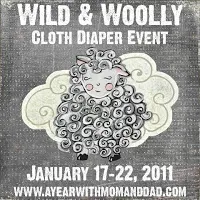
So, we’re more than halfway through the Wild and Woolly Cloth Diaper Event. Are we having fun yet? I know this is the post you’ve all been waiting for. It’s why most of us have shied away from wool for so long. It’s why I bought a wool cover and let it sit on the changing table unused for over a month.
The. Big. Mystery. How do you wash and care for your wool?
You will laugh when you see how easy it is. I did. The biggest thing is DON’T put your wool covers in the laundry – otherwise you risk shrinkage/felting, depending on how hot the water is and how much agitation it gets (I have felted many a sweater right down to Barbie-sized proportions this way!). So, always hand-wash.
Later today, I will have a review and giveaway of wool-care products, where I talk you through my first experience washing and lanolizing my wool covers. But here are some instructions straight from one wool expert, Vilate Thacker of Nifty Nappy:
Washing and Lanolizing Wool Covers:
I am sure I will get some flack from this… but you really can NOT use a wool wash with lanolin in it to lanolize wool covers. The wool will not work as good because you are NOT getting it clean. The one step does not allow the wool to get all the way clean before the lanolin is introduced, so you are really partially cleaning it and then lanolizing over the dirty. This will not give your wool the chance to get entirely clean so it can perform the salinization process as many times as it would after lanolizing. So your cover will need to be washed more often and will not work as well. I know some ladies want to make it shorter to care for them… but there really is no cutting corners. Here is how I suggest you care for wool covers.
- Use any type of pure lanolin. Buy it at the store for nursing mothers, or buy it in bulk off the Internet.
- Always hand-wash your woolies and hang to dry!
- Wash the woolie in lukewarm water and baby soap or wool wash. Wring the water out.
- Fill a bowl, not your sink, (the wool fibers might clog your sink) with luke-warm water.
- Boil about 1 cup water in microwave, then add pea size amount of lanolin per woolie and about the same amount of baby soap. (an emulsifier to help dissolve the lanolin) When the lanolin is dissolved the water will be milky.
- Add dissolved lanolin to your bowl of water and stir in.
- Put the woolie in the bowl (inside out works best, it puts the lanolin where it is needed) and massage the lanolin in. Leave to soak for between 4 –8 hrs. (overnight works great!) Occasionally come back and massage the lanolin in a bit more.
- Wring the water out. You have to get most of water out for faster drying. There are two ways to do this:
- You can roll it up in a towel and squeeze the water out. I don’t like this method; I think the towel wicks away too much of the lanolin.
- You can throw them in your washer on the spin cycle and spin the water out.
- Now hang them out to dry, inside at least 12 hrs.; outside 6-8 hrs.
Your woolie should only need to be washed and lanolized about once a month. If they get soiled with food, dirt, or baby poo then they will need to washed and re-lanolized. If they get wet you replace them with another and hang out to dry. The lanolin in the woolies will help the wool turn the urine into salt water. If the woolie starts to smell like urine after dry then you should wash and re-lanolize.

